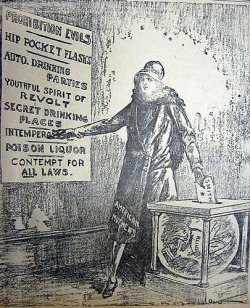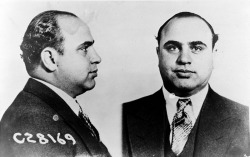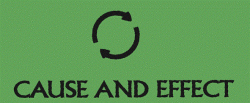Social Aspects of the 1920s
PROHIBITION AND CRIME
Key Vocabulary
Speakeasy - an illegal bar during Prohibition
Bootlegger - one who makes or sells illegal liquor; moonshiner
Bootlegger - one who makes or sells illegal liquor; moonshiner
The 18th Amendment

The evils of prohibition
By 1913, The Anti-Saloon League with the help of The Women's Christian Temperance Union finally controlled a two-thirds majority seat in both the Senate and the House of Representatives. As America entered WWI, prohibitionists grew stronger and stronger, saying that the grain would be better used as food for the war effort and that sober soldiers were better than drunk soldiers. Finally passing Congress on December 18, 1917, the 18th Amendment prohibited the manufacture, sale, and transportation of "intoxicating liquors" in the United State. Two years later, the amendment was ratified, officially going into effect on January 17, 1920. At first, this amendment showed a decrease in drunken arrests and liquor consumption.
However, the government did not realize how hard it was to regulate alcohol. As the cartoon above depicts, the passage of the 18th Amendment inadvertently led to many evils and ways of escaping the law. Hip flasks as well as other inconspicuous ways of carrying small amounts of alcohol around (such as hollowed-out canes and books) became popular. Bootleggers illegally made alcohol and distributed it for personal profit. Speakeasies were bars that posed as innocent institutions while they secretly dealt out alcohol to anybody that wanted it. By 1925, there were 30,000-100,000 speakeasies in New York City alone. Also, the forbidding of alcohol led to people having a general contempt for all forms of the law, because they didn't believe that the government should be able to regulate a commodities.
However, the government did not realize how hard it was to regulate alcohol. As the cartoon above depicts, the passage of the 18th Amendment inadvertently led to many evils and ways of escaping the law. Hip flasks as well as other inconspicuous ways of carrying small amounts of alcohol around (such as hollowed-out canes and books) became popular. Bootleggers illegally made alcohol and distributed it for personal profit. Speakeasies were bars that posed as innocent institutions while they secretly dealt out alcohol to anybody that wanted it. By 1925, there were 30,000-100,000 speakeasies in New York City alone. Also, the forbidding of alcohol led to people having a general contempt for all forms of the law, because they didn't believe that the government should be able to regulate a commodities.
Prohibition Enforcement - The Volstead Act and Padlock Laws
To help enforce the 18th Amendment, Congress passed the Volstead Act. This act attached a specific definition to alcohol, giving the government a higher potential to regulate it. It made illegal any drink that was made up of more than 1% alcohol. First time offenders to this law had a possibility of getting put in jail for up to six months as well as a $1,000 fine. Second time offenders served up to five years in jail and were made to pay a $10,000 fine.
Padlock Laws allowed government agents to close a business institution for up to a year if it was discovered to be distributing alcohol. These laws also increased the government's domain by allowing them to seize any automobiles that were illegally transporting liquor.
Padlock Laws allowed government agents to close a business institution for up to a year if it was discovered to be distributing alcohol. These laws also increased the government's domain by allowing them to seize any automobiles that were illegally transporting liquor.
Gangsters and Crime of the 1920s

Al Capone - leader of a crime syndicate
The 1920s is also known as the age when gangs had a sudden emergence and crime levels started to spike. Part of the reason behind the crime levels was the 18th Amendment, prohibiting all things dealing with alcohol. As shown above, prohibition led to people having contempt for all laws. As a result of this, areas experience "people in revolt" as well as a sort of underground alcohol ring. One area that witnessed increased crime syndicates was San Francisco, California. There was frequent violence between gangs and law enforcement officers as the gangs attempted to smuggle liquor into the streets of San Francisco. On December 5, 1920, two police officers were killed by three members of an organized gang of Bootleggers known as the Howard Street Gang. The suspects were apprehended and jailed, but an angry mob stormed in one night and lynched all of them.
A lot of the crime during the time dealt with bootlegging alcohol. The government wanted prohibition laws as a means to decrease crime rates. But since this banning of alcohol only angered people even more, crime rates actually increased. The police had to work harder to keep a watchful eye over bootleggers and as a result, more serious crimes were overlooked. Also, because of the poorly-made alcohol by bootleggers and bootlegging gangs such as the Howard Street Gang, alcohol poisoning increased by over 400% during the twenties. Another type of crime that became popular towards the end of the 1920s was bank robbery. In cities with many banks, such as Chicago, criminals found that robbing them got them a lot more money a lot quicker.
Commonly associated with crime syndicates of the time, Al Capone led a syndicate that specialized in smuggling and bootlegging alcohol during the 1920s. Although making his beginnings in Brooklyn, Capone eventually moved his career to Chicago. One of the events he was involved with was the Saint Valentine's Day Massacre in which seven people were killed in a gang war between the South Side Italian gang (led by Capone) and the North Side Irish gang (led by Bugs Moran). In 1931, Capone was indicted by the government for tax evasion and was in turn sent to a variety of prisons, most of which he was still able to keep "special priviledges".
This insurgence of crime led to what was known as the "public enemy era" in the early 1930s, where bank robberies and murders became run-of-the-mill in big cities. Such big name criminals of the time were Bonnie and Clyde, John Dillinger, and Lester "Baby Face Nelson" Gills.
Also, in 1919, the Thompson submachine gun (a.k.a. - the tommy gun) was created. This gun became the staple weapon that symbolized gangsters in the 1920s. It was used in the Saint Valentine's Day Massacre (11% of the kills were made by the tommy gun) and was labeled as "the gun that made the twenties roar".
A lot of the crime during the time dealt with bootlegging alcohol. The government wanted prohibition laws as a means to decrease crime rates. But since this banning of alcohol only angered people even more, crime rates actually increased. The police had to work harder to keep a watchful eye over bootleggers and as a result, more serious crimes were overlooked. Also, because of the poorly-made alcohol by bootleggers and bootlegging gangs such as the Howard Street Gang, alcohol poisoning increased by over 400% during the twenties. Another type of crime that became popular towards the end of the 1920s was bank robbery. In cities with many banks, such as Chicago, criminals found that robbing them got them a lot more money a lot quicker.
Commonly associated with crime syndicates of the time, Al Capone led a syndicate that specialized in smuggling and bootlegging alcohol during the 1920s. Although making his beginnings in Brooklyn, Capone eventually moved his career to Chicago. One of the events he was involved with was the Saint Valentine's Day Massacre in which seven people were killed in a gang war between the South Side Italian gang (led by Capone) and the North Side Irish gang (led by Bugs Moran). In 1931, Capone was indicted by the government for tax evasion and was in turn sent to a variety of prisons, most of which he was still able to keep "special priviledges".
This insurgence of crime led to what was known as the "public enemy era" in the early 1930s, where bank robberies and murders became run-of-the-mill in big cities. Such big name criminals of the time were Bonnie and Clyde, John Dillinger, and Lester "Baby Face Nelson" Gills.
Also, in 1919, the Thompson submachine gun (a.k.a. - the tommy gun) was created. This gun became the staple weapon that symbolized gangsters in the 1920s. It was used in the Saint Valentine's Day Massacre (11% of the kills were made by the tommy gun) and was labeled as "the gun that made the twenties roar".
Thinking Like a Historian - Cause and Effect

As a result of the Anti-Saloon League and the prohibition movement gaining more and more momentum, the 18th Amendment prohibiting the manufacture, sale, and transport of alcohol finally passed through Congress. In order to enforce this new amendment, the Volstead Act and the Padlock Laws were passed, imposing heavy fines and punishments on people who disobeyed the law. However, this only made people more rebellious. People started carrying around concealed hip flasks containing alcohol. Underground bars known as speakeasies were created to secretly distribute alcohol to the masses. Crime syndicates arose to traffic liquor and sell it underground. Because of the strict prohibition laws the government set up, gangsters and crime became a feature of the twenties, provoking many disputes about what gangs control what territory and leading to events such as the Saint Valentine's Day Massacre.
Primary Source - A Glimpse behind the Mask of Prohibition, by Percy Andreae
Percy Andreae was an affluent anti-prohibition speaker who organized resistance to the Anti-Saloon League in the early 20th century. The Anti-Saloon League fought for and obtained the 18th Amendment and how the government regulated this prohibition amendment.
In this source, Andreae challenges the belief system of prohibitionists and states that most prohibition movements stem from people who have been personally affected by the effects that alcoholism can have on a person and the people around him. This leads to a radical ideal that if alcohol did something bad to this life and this person can't have it, then nobody should be able to have it. In other words, prohibition begins with the belief that temptation for the individual can be overcome by stopping the society from drinking. Another reason for prohibition comes from the religious who believe that God will frown upon them if they indulge in any material pleasure.
Also, Andreae believes that there's no use in it. All prohibition does is prohibit the sale of alcohol, not the consumption of it. If prohibition movements were to outlaw the consumption of liquor, then it would ultimately lead to the demise of the movement, because people voting for the prohibition laws aren't willing to sacrifice their own right to drink.
Andreae states that the prohibition cause is merely a facade for advancing the religious beliefs of certain sects.
Drinking, like all other vices, had become better managed in the 1920s with moderation and appropriate education.
In this source, Andreae challenges the belief system of prohibitionists and states that most prohibition movements stem from people who have been personally affected by the effects that alcoholism can have on a person and the people around him. This leads to a radical ideal that if alcohol did something bad to this life and this person can't have it, then nobody should be able to have it. In other words, prohibition begins with the belief that temptation for the individual can be overcome by stopping the society from drinking. Another reason for prohibition comes from the religious who believe that God will frown upon them if they indulge in any material pleasure.
Also, Andreae believes that there's no use in it. All prohibition does is prohibit the sale of alcohol, not the consumption of it. If prohibition movements were to outlaw the consumption of liquor, then it would ultimately lead to the demise of the movement, because people voting for the prohibition laws aren't willing to sacrifice their own right to drink.
Andreae states that the prohibition cause is merely a facade for advancing the religious beliefs of certain sects.
Drinking, like all other vices, had become better managed in the 1920s with moderation and appropriate education.

